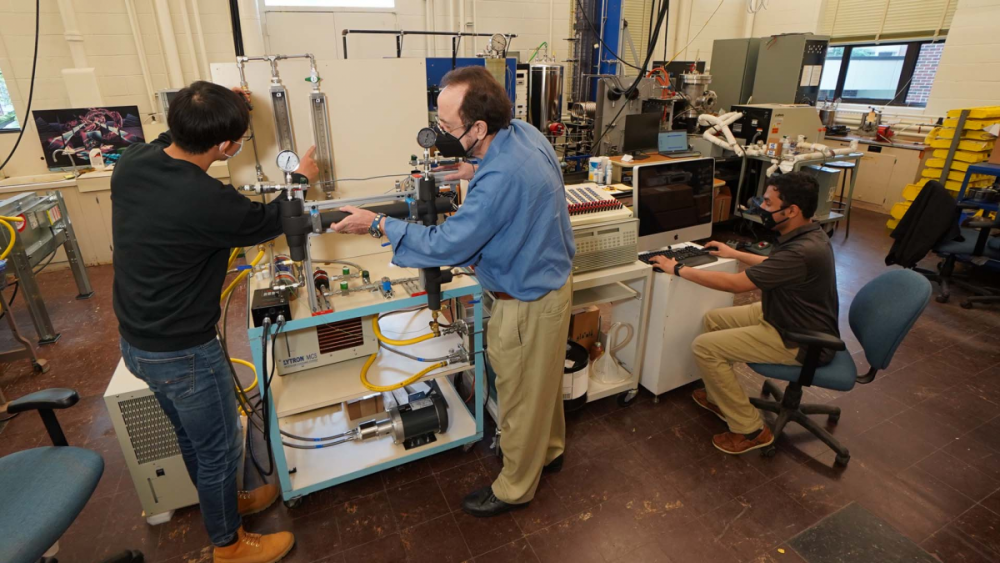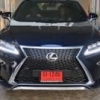Search the Community
Showing results for tags 'electric vehicle'.
-
Electric cars are known to be efficiency powerhouses, but how much can you really save? Charging an electric car will likely cost significantly less than filling up an ICE car with gasoline or diesel. But, how much can you save, and why is it cheaper to run on electrons than liquid fuel? Before looking at the price comparison, it's essential to understand that the lower ownership costs are not just about electricity versus gasoline prices. Here are some aspects of electric cars that yield lower overall fueling prices. Aerodynamics In typical gasoline cars, aerodynamics are essential but not typically of the utmost concern. Electric cars are different. Since batteries are the most expensive component in most EVs, they require a very slippery drag coefficient to maximize their range. As explained by AirShaper CEO Wouter Remmerie, a low drag coefficient is the key to allowing your EV to get the most amount of range. "If you double your speed, the aerodynamic force goes up by a factor of four," Remmerie told InsideEVs. Remerie estimated, "you can go 200km/h in a 200 horsepower sports car, but you need 1600 horsepower to go 400 [km/h]." While these numbers are far higher than typical U.S. highway speeds, it reveals that it's vital to master aerodynamics so EVs can travel on long highway stretches and still attain sufficient range. Overall Efficiency Unlike internal combustion cars, electric cars have the upper hand because they use far less energy. According to the Department of Energy (DOE), a typical gasoline car would have an efficiency (energy to the wheels) of less than 25%. This means that the other 75% of energy would be lost as heat or used in other internal combustion engine systems. Disregarding the benefits of regenerative braking, electric cars have an efficiency of over 65%. The other 35% is energy lost in charging and drive system losses (battery system cooling and heat). Regenerative Braking In traditional non-hybrid cars, deceleration is primarily done with their friction brakes. This means that lots of kinetic energy is simply wasted as heat. In hybrids and EVs, most braking is done through capturing kinetic energy and transferring it as electrical energy back into the battery pack. With this braking method, electric cars can recuperate energy back into the battery rather than wasting the energy as heat into the surroundings. According to the DOE, a typical EV's total efficiency (factoring in regen) is around 90% in the combined cycle. So, How Much Will You Save? While most articles will compare two of the best-selling EV and ICE sedans, like the Tesla Model 3 and the Toyota Camry, choosing two closely-sized and similarly-priced cars is far more realistic. The Toyota Corolla and the Nissan Leaf will be the two contenders in this comparison. The Nissan Leaf is the best-selling electric car that costs less than $30,000, and the Corolla was the second best-selling sedan this August (Car Pro USA). 2022 Toyota Corolla L (non-hybrid) $20,075 139 horsepower 30 city / 38 highway mpg 3.0 gallons / 100 miles 436-mile total range 2022 Nissan Leaf S 40kWh $27,400 ($19,900 incl. Federal tax credit) 147 horsepower 123 city / 99 highway mpge 30 kWh / 100 miles 150-mile total range To make this comparison fair, we will use the U.S. annual average mileage of 13,476 miles (U.S. Department of Transportation). We will also use the average U.S. home energy rate of $0.1252 per kWh (Electric Choice) and the average regular gas price of $3.285 a gallon, as of December 31, 2021 (AAA). For the Corolla, we will divide the total annual mileage of 13,476 miles a year by 100 miles and then multiply that number by 3.0 gallons to get a total of approximately 404 gallons of gasoline used in one year. Multiplying this gas price by $3.285 a gallon, it'll cost about $1,328 each year on gasoline for the Toyota. For the Leaf, we'll divide 13,476 miles by 100 miles and then multiply that quotient by 30kWh. In one year of driving a Leaf, it'll use around 4043kWh of electricity. Multiplying this by the average U.S. energy rate of $0.1252 per kWh, the Leaf will only cost $506 a year on electricity. This sum could fall to an even lower value, factoring in free public charging and $250 worth of EVGo credits in partnership with Nissan. Conclusion Each year, an electric car like the Leaf could save you $822 in fueling costs over a typical gasoline-powered sedan. In four years of ownership, this value could jump to $3,288, and in eight, you could save $6,576. With rising gasoline prices and an increased emphasis on electric vehicle incentives, now's the time to make the switch!
- 235 replies
-
- 4
-

-
.png)
-
- electric vehicle
- mainteanance
-
(and 3 more)
Tagged with:
-
exciting stuff, especially range and specs, premiering soon.. https://www.cnbc.com/2021/02/17/photos-hyundais-new-electric-crossover-ioniq-5s-sliding-console.html https://www.theverge.com/2021/2/16/22285235/ioniq-5-sliding-universal-island-e-gmp https://hyundai.com.sg/globalnews/196?utm_source=Facebook&utm_medium=Social&utm_campaign=AO&fbclid=IwAR0POL_LzewptkiHXMmqIcOVB5pLqoo2ouZWiaeE-g5T1Klz8x_NfCeLI9o
-
Source: https://www.straitstimes.com/business/no-one-wants-used-evs-making-new-ones-a-tougher-sell-too BERLIN – The shift away from cars with dirty combustion engines is running into a new hurdle: Drivers do not want to buy used electric vehicles (EVs), and that is undermining the market for new ones, too. In the US$1.2 trillion (S$1.6 trillion) second-hand market, prices for battery-powered cars are falling faster than for their combustion-engine cousins. Buyers are shunning them due to a lack of subsidies, a desire to wait for better technology, and continued shortfalls in charging infrastructures. A fierce price war sparked by Tesla and competitive Chinese models are further depressing values of new and used cars alike, threatening earnings at rivals like Volkswagen (VW) and Stellantis. Because most new vehicles in Europe are sold via leases, automakers and dealers who finance these transactions are trying to recover losses from plummeting valuations by raising borrowing costs. That is hitting demand in some European markets that were in the vanguard of the shift away from fossil fuel-powered propulsion. Some of the biggest buyers of new cars, including rental firms, are cutting back on EV adoption because they are losing money on resales, with Sixt dropping Tesla models from its fleet. “When a car loses 1 per cent of its worth, I make 1 per cent less profit,” said Mr Christian Dahlheim, who heads VW’s financial services arm. The issues with second-hand EVs, he added, have the potential to destroy billions of euros in earnings for the broader industry. The problems are expected to intensify in 2024, when many of the 1.2 million EVs sold in Europe in 2021 will come off their three-year leasing contracts and enter the second-hand market. How companies tackle this problem will be key for their bottom lines, consumer confidence and ultimately decarbonisation – including the European Union’s plan to phase out sales of new fuel-burning cars by 2035. “There isn’t used-car demand for EVs,” said Mr Matt Harrison, Toyota Motor’s chief operating officer in Europe. “That’s really hurting the cost-of-ownership story.” Companies can funnel battery-powered cars into mobility offerings and ride-sharing start-ups, but there is limited demand from these businesses. Unwanted combustion cars often end up in Africa, where their poor state causes pollution issues. That market is largely shut to EVs because it has no viable infrastructure to charge them.
-
A recent meet up with some friends and auto buddies led me to think if I should jump onto the latest trend, and the biggest thing in the automobile industry now is the tide of change, from internal combustion engines (ICE)s to electric vehicles or EVs. With the COE of my car running out in just a little more than three years, I am keen watching this page. But if I go by current trends, costs and also a deeper dive, I am likely to stay with the traditional gas guzzler. For context, I have to mention my current car usage. My trip to work is rather short, with minimal traffic jams. I do commute between two to three worksites, which is made much easier by hopping into the car and then driving between these destinations. They are also not too far apart, but if I factor in time for taxis or private hire vehicles (PHV)s, I will spend a significant amount of time waiting. There are no direct buses between the sites. I also take longer journeys on the weekend to fetch my little one to enrichment classes, visit the in laws, church and such. With the family in tow, all four seats as well as the baby seat are filled up on such runs. I also do errands. However, the operating radius is not large apart from the occasional runs or meet up with friends and business related meet ups. So my annual mileage works out to be just a tad over 10 000km, which is not a lot by anyone's standards. Now let's look at the three basic kinds of engines you can choose from now. ICEs, hybrids and EVs. I have the ability to charge near or at my home or access them easily at work. Currently there are certain 'perks' that the government is offering for cars with better emissions. Why the inverted commas? Well these so called rebates are handed to the seller / car makers to package into their pricing, BUT and this is the big but, you have to return half of these rebates when you scrape the car! Secondly, let's talk about the battery cost. Whilst it may seem that you save on petrol costs, especially if one gets a EV, don't forget to check the cost of the battery. There are now more and more reports of sticker price tag shocks for EV owners when they need to fix or replace these batteries. We are not talking hundreds or even thousands of dollars. We are talking tens of thousands, yep, costs that amount to the that which may match the OMV or basic cost of the car. You might feel it will not happen to you, but some of these 'accidents' are basically nothing more than going over the kerb or bumps and scratching the bottom of the cars. The stuff even the most careful drivers may end up doing once in a while. Now imagine facing such a bill and finding out that the EV has little residual value if the battery is kaput. Or a monumental repair bill to fix or replace that battery. How about hybrid cars? Again, if you drive like a cabbie, and accumulate 30 to 40k a year, it might make more sense, since you get significantly higher mileage with the true hybrids than a ICE car. The car hybrid battery tends to require replacement around the eighth or ninth year, just when many car makers end their battery related warranty. So you may be a few thousand dollars out of pocket when you wish to replace that battery, and then unless you renew the COE, that car will only be driven for a couple more years. So you really have to sit down and fish out that calculator and determine if the annual mileage, the total amount of petrol saved justifies the outlay for the battery. Some hybrid cars are only hybrid in name with a token battery just to get that rebate, so you need to check the details and do the maths. You will also need to add in maintenance, and whilst EVs tend to require less visits to the workshop for the engine, you need to make sure there are trained mechanics which can back up the car, and the numbers are thin on the ground currently, even if you return to the original sellers. Many do not, baulking at their charges, but with the kind of electronics inside, things could get dicey if you go beyond just tires and wiper replacement. As for tires, you also need to know EVs use larger wheels and also different tires. Many budget cars currently run on 15 or 16" wheels and you spend about $100-$150 per tire. Expect to double or triple that for EVs, due to their heavier weight. Speaking of maintenance, the EVs are not entirely similar to their ICE cousins. Ever sat in a Tesla or even a BYD? It feels more like a PC on wheels than your traditional car. Some Tesla owners have been caught out when their cars are doing software updates, and you could have a dead car just when you need to rush out. There are changes afoot, but touchscreens are harder to use when you're driving and having to dive four or five layers into their menu just to turn down the volume or air con temperature is not only a hassle but dangerous whilst driving. Now that we are talking about the interior and ergonomics, I also dislike the Tesla car handles. You need to pry them out, and I much prefer the traditional ones with a generous hand grip. Try handling groceries or a struggling baby whilst opening your car door and you'll understand. The other issue is safety. We already mentioned that you can crash the OS, so you're effectively locked out of the car. How about potential fires? Already, with the advent of personal mobility devices, we are witnessing huge increases in household fires related to charging issues. Overseas we have witness huge balls of fires when the EVs burst into flames. Firemen often standby and wait for the fires to burn out, because it is really hard to put out the fires related to the batteries. Woe betide any cars parked next to them. Is my decision process too conservative, too dated? There is still some time before I need to commit so I shall be watching this EV / hybrid space very intently.
- 2,634 replies
-
- 20
-

-
- electric vehicle
- hybrid
-
(and 1 more)
Tagged with:
-
https://www.torque.com.sg/features/shaping-the-future-with-audi-design/ In a decade, Audi claims that the company will go 'fully electric' as the world moves forth in its quest for environmental stewardship and climate sustainability. This ambitious goal will make the brand industry pioneers of a new generation of automobiles. With a new skysphere concept, Audi aims to create vehicles that can physically transform themselves to fit the driver. An SUV might be able to shorten its wheelbase and lower itself to make it more agile in tight spaces. While this concept looks and sounds cool (like something out of a sci-fi film), is it truly enough to fulfill the futuristic vision that the brand has? What are your thoughts on this?
- 10 replies
-
- 3
-

-
- audi
- electric vehicle
-
(and 2 more)
Tagged with:
-
There's been some hype around these 2 stocks lately from earnings. I've got enough money to invest in just one, can't decide between the two. (p.s. I hold bit of Tesla, looking to diversify and for cheaper EV stocks)
-
Sweden FTW! A true demonstration of going all out to go green. Using 1 container to ship 20 cars instead of 4, the reducing in carbon footprint is evident, not to mention the lower shipping cost. Ingenious Luvly — a manufacturer from Sweden — has created a method to reduce the shipping costs of its tiny electric car, which has a starting price of €10,000 and is less than nine feet long Source: https://english.elpais.com/economy-and-business/2023-04-23/the-ikea-swedish-car-that-comes-to-your-home-in-parts.html The arrival of electric vehicles (EVs) has allowed for a huge number of new players in the automotive world to emerge. These companies are staking out new territory, competing against established brands in the EV sector. Luvly — a Swedish firm — is one of them. The car manufacturer wants to stand out for its emission-free tiny cars… and for its peculiar delivery system, which has already caused a commotion. With the aim of reducing costs, Luvly has created a system very similar to that of its compatriot, Ikea: the cars are manufactured in pieces before being sent to their destination. This means that shipments can be used much more economically, to the point that, in a container with a capacity for four cars, it’s possible to fit the parts needed for 20 Luvly vehicles. Of course, contrary to what happens with furniture, it won’t be the buyer who is in charge of assembling it. The company will have different regional factories that will be in charge of the assembly. This methodology will apply to all of Luvly’s models, of which several are already planned, such as a three-wheeled sports car, or a small van. But, for the moment, only the first model — Luvly 0 — has seen the light of day. This vehicle is specifically meant for urban use. It’s a very small car that has been designed to move around agilely in the city, occupy a minimal amount of space, consume little energy and, at the same time, maximize the interior. The result is a model with a minimalist design, with a broad windshield and a straight-cut at the rear. The optical groups are very discreet, while the wheels — each one with its own fender — are placed at the four ends of the body. The Luvly 0 car only measures nine feet in length, five feet in width and 4.7 feet in height. These dimensions allow it to be a really light vehicle that only weighs 840 pounds. And, while it’s a two-seater model, it also has a good-sized trunk. Given its urban character, the car’s mechanical section does the job, taking into account its objectives. The brand doesn’t highlight its power, but it can reach speeds of up to 55 miles per hour. One of the strengths of the Luvly is that it has a 6.4 kilowatt battery. It’s divided into two removable modules — each weighing 33 pounds — so it’s possible to charge it at home. In addition, since its energy consumption is very low, a single charge can take it as far as 60 miles. The brand already allows you to sign up on its website to place orders, with a starting price of €10,000 ($11,000).
- 10 replies
-
- 8
-

-
- electric vehicle
- swedish
-
(and 3 more)
Tagged with:
-
If you're a new EV owner who is wondering how to avoid range anxiety and get the most out of your new car, here's a quick primer for you! More and more people are now electrifying their drives with EVs. To get the most of your new EV and soothe any range anxiety, here's what you should and shouldn't do. Charge+Charging 1. Plan your charging schedule with your lifestyle Based on the average daily mileage of about 50km for private cars in Singapore, most EV owners would only need to charge their cars once a week. You can easily incorporate this once-a-week session into your lifestyle by choosing to charge your car overnight. This option, also known as slow charging, uses alternating current (AC), is not only convenient for drivers, but it also poses a much lower burden on the electrical infrastructure. Similar to charging your mobile phone overnight, you can do the same for your EV and wake up to a fully charged car. Most public charging points in Singapore at shared residential carparks are slow chargers that support overnight charging. On the other hand, if you prefer to dovetail it with your regular activities such as buying groceries, getting a haircut, or even just having breakfast with your family at a nearby cafe while your car is being charged, you can opt for fast charging that uses direct current (DC), which is available at some shopping malls, office buildings, and even select petrol stations. 2. Use the MyTransport.SG app to find the nearest charging point By 2025, every HDB town will be EV-ready, which means there will be charging points in nearly 2,000 HDB carparks over the next three to four years. By 2030, there will be around 60,000 charging points! No need to worry, though, because finding one near your most frequented places or in a building where you'll be meeting clients for an appointment has been made easier with the MyTransport.SG app. Once you have the app on your phone, you can quickly access information on where you can find the most convenient charging spot. MyTransport.SG doesn't just display available charging locations, though. It also shows you the type of plug, power rating, and price. This offers drivers convenience and enables them to make informed decisions. You can also use the app to filter and search for charging points, be redirected to the respective charging operators' apps to make payments, or to Google Maps for navigation. Very handy. 3. Park in an EV lot only when charging EV charging points are meant specifically for that - to charge electric vehicles. Once you are done charging, do move your vehicle and park it in a regular lot, so that other EV users who wish to charge their car can do so. EV276 EV Charging 4. Charge only up to 80% While you may be tempted to fully charge your EV, sometimes less is more. Studies have shown that an EV's charging rate slows down once it reaches this level of charge, so you may want to consider unplugging at 80%, and save yourself time in the process. This also helps prolong your EV's battery life, so it's a win-win. 5. Return the charging gun properly Don't forget to place the charging gun firmly back in its holster when you're done. This helps prevent it from getting damaged (just imagine if it was left on the ground and it got run over by a car!) and reduces the risk of people tripping over the cable. There you have it! Charging an EV can be fuss-free and convenient. With these quick and easy tips, you can say goodbye to range anxiety and power up your EV the right way.
-
Switching to an electric car gives you a smoother, emission-free drive. Much has changed since electric cars entered the scene about a decade ago. Back then, the thought of owning - or even driving - an electric car was a remote one, with few electric vehicles (EVs) and charging points available. Spotting one in public was like sighting a unicorn. Today, the EV landscape has totally transformed, with practically every brand producing EVs. They even come in a range of models - from sedans, SUVs, hatchbacks, and more. Alongside this, charging points in Singapore are also more widely accessible. Given the availability of EV charging points across the island, and how EVs give a smoother, emission-free drive, now could be the time to consider switching from a regular internal combustion engine (ICE) car to an EV. Here are the reasons why. Incentives & rebates First things first: When you buy an EV in Singapore, you can avail the incentives launched by the Land Transport Authority (LTA) to electrify our vehicle population as it works towards having 100% cleaner energy vehicles by 2040 under the Singapore Green Plan 2030. This means you can take advantage of the EV Early Adoption Incentive, which grants those who register an electric vehicle a rebate of up to 45% off the Additional Registration Fees (capped at $20,000). You may also be able to qualify for the Enhanced Vehicle Emissions Scheme, which offers rebates of up to $25,000 for cars classified under the A1 Band. Plus, with the Revised Road Tax Framework, the road tax for mass-market EVs has become more comparable to that of their ICE equivalents. In fact, LTA has already revised the Maximum Power Output threshold for EVs from 97kW to 110kW, so that more mass-market EV models now fall under the less expensive COE Category A. In total, these incentives give buyers of new EVs combined savings of up to $45,000 in rebates. Those whose cars are in the 90-230kW power rating bracket will see their annual road tax reduced by up to 34%. Cheaper maintenance So EVs are more affordable compared to when they first hit the market. How about maintaining it? An EV's electric motor is simpler and has fewer components. Apart from improved reliability, this also means the battery, motor and associated electronics require little to no regular maintenance. There are fewer fluids and parts that need to be maintained, changed, or replaced such as engine oil, oil filters, air filter, spark plugs, fuel filters, timing belts and radiators. Regenerative braking - an innovative feature in EVs that helps recharge batteries on the go by transforming kinetic energy from braking back into electric energy stored in the car's batteries - reduces brake wear and the build-up of brake dust. This extends the life of parts such as cables and brake pads. Combining all these savings, the cost of maintaining an EV can be just up to a third of the expense of maintaining an ICE vehicle, thereby lowering your running costs. A smoother drive If you've never driven an EV and you're wondering how driving one will compare to its ICE counterpart, you will be pleasantly surprised. A huge advantage is that the EV's electric motor delivers torque instantly, whereas a petrol-powered engine still needs to increase its revolutions per minute (RPM) to increase its power output. This translates to a seamless and rapid power delivery, which - as we at SGCM can attest to after having test-driven EVs of all makes and models - makes an EV feel sharper and more responsive. Quieter and more comfortable rides Having an electric motor also has near-zero levels of vibration and operating it produces significantly less noise than an ICE car. Apart from improving your comfort level inside the car, you can also enjoy music and have better conversations with your passengers with less distractions due to the absence of engine noise. Better range, less anxiety Range anxiety, or the fear that your car battery may die while you're on the road, is very much a real thing, especially back when charging points used to be far and few between. With many EV models now offering a driving range of at least 350 km though, you have less to worry about. This is more than sufficient to meet the needs of the average motorist in Singapore. Generally speaking, most drivers average 50km a day commuting to and from work, with perhaps an errand or two in between. An EV with around a 350 km range means you should only have to charge it approximately once a week. Recharging can be as simple as plugging it in once a week when you get home, leaving it to get 'juiced up' overnight, and driving off the next day with a fully-charged battery. More charging points coming your way In addition, Singapore's EV charging network is rapidly expanding. As of today, there are already over 3,000 charging points island-wide, with more on the way. In just three years' time, every HDB town will be EV-Ready, with charging points in nearly 2,000 HDB carparks. It won't stop there. As EV adoption increases, LTA will deploy additional charging points to meet the higher EV charging demand. By 2030, Singapore will have 60,000 EV charging points. Easier to find charging points Finding a charging point is not like finding a needle in the haystack anymore. Just use the MyTransport.SG app to find charging points offered by the major providers. Apart from helping you locate charging points, the app also displays information such as pricing, power rating and type of plug to help drivers plan their charging schedule, as well as the real-time availability of EV charging points - starting with those under CDG-E & SP Mobility. After finding your preferred charging point in the app, you will be redirected to the operator's app for payment, or to Google Maps for navigation. Upgraded safety standards EVs come with Battery Management systems that regulates the charge voltage, temperature, and battery health, ensuring that the EV's batteries operate and is charged within its prescribed safety limits. In addition, Singapore's updated EV charging standard, Technical Reference 25 (TR25) stipulates the proper installation of charging points and mandates periodic safety inspections. TR25 is reviewed not just by the Government, but also by industry and academic stakeholders to ensure that Singapore stays relevant in the landscape by incorporating the latest EV charging technologies and supporting the safety of the EV ecosystem in the country. For example, under TR25, the use of household extension cords to charge EVs from 13 Ampere household sockets is banned. Low-powered charging is permitted using 15 Ampere (15A) sockets, with each socket allowed to serve only one charger at a time to avoid electrical overloading. Singapore also adheres to international standards like United Nations Economic Commissions for Europe R100 (UNECE R100) to reduce the risk of electrical, thermal, or mechanical failures. Better for the environment Climate change is a real issue that affects everyone, which means we should all play a part in alleviating it - such as by switching to EVs if we need a car. EVs are significantly more environmentally friendly compared to ICE cars in more ways than one. An EV emits half the amount of carbon dioxide (CO2) than a comparable ICE vehicle. This means that if all cars in Singapore are EVs, carbon emissions would be reduced by an astounding 1.5 to 2 million tonnes. With an average car weighing about 1.5 tonnes, that would make it equivalent to the weight of up to 1.3 million cars! EVs also help curb noise pollution as they produce less noise than ICEs, particularly at low speeds. With the prospect of minimum noise levels to be regulated under new laws in Singapore for technical standards and safety precautions soon, driving an EV, which emits less noise than an ICE vehicle, will put you ahead of the curve. To switch or not to switch If it's inertia that's holding you back from making the switch, consider this the push that you need. EVs are quieter, more environmentally friendly, and deliver smoother performance compared to ICE vehicles. The charging infrastructure has evolved to be more convenient and accessible, with even more improvements in the horizon. So, should you now consider switching to an EV? It is, quite simply, an easier question to answer than ever before and the thought of owning an EV in Singapore is truly a viable option that needs to be seriously considered.
- 1 comment
-
- electric vehicle
- electric car
-
(and 1 more)
Tagged with:
-
- 27 replies
-
- 7
-

-

-
A local company has started offering a mobile charging service for electric vehicles (EVs). This is said to be the first of its kind in Singapore. The service by Power Up Tech (P.Up) is targeted at EV owners who may not have convenient access to a permanent charging point. Each visit lasts 30 minutes to an hour to bring the EV up to about 80 per cent of battery charge. So range anxiety is not a problem anymore. Maybe while waiting can also charge handphone. 😄
- 51 replies
-
- 11
-

-
- electric vehicle
- hybrid
-
(and 2 more)
Tagged with:
-
https://www.channelnewsasia.com/singapore/electric-vehicles-ev-charging-points-hdb-car-parks-2025-2547471 Nearly 2,000 HDB car parks to have at least 3 EV charging points each by 2025 File photo of an electric vehicle (EV) charging point in Singapore. (Photo: iStock/taikrixel) Grace Yeoh Grace Yeoh 08 Mar 2022 01:37PM (Updated: 08 Mar 2022 01:37PM) Bookmark Share SINGAPORE: To make every Housing and Development Board (HDB) town “EV-ready” by 2025, nearly 2,000 HDB car parks will each have a minimum of three charging points. These charging points will “mostly provide low-powered, overnight charging”, to meet the needs of car owners and minimise the load on the electrical grid, said Transport Minister S Iswaran on Tuesday (Mar 8). Advertisement Speaking during a multi-ministry joint segment on the Singapore Green Plan 2030 at the Committee of Supply debate, Mr Iswaran said more charging points will be installed in car parks where there is demand and adequate electrical capacity. The Land Transport Authority (LTA) said in a press release that the move is a “significant step” in achieving Singapore’s target of 60,000 EV charging points by 2030. A “large-scale tender” for HDB car parks will be launched in the first half of this year, it added. Singapore’s land transport emissions peaked at 7.7 million tonnes of carbon dioxide equivalent (MtCO2e) in 2016 - way ahead of the 2030 timeline set at the national level, LTA said. As such, the Government has set a new target of reducing emissions by 80 per cent from the 2016 peak by around 2050.
- 71 replies
-
- 1
-
.png)
-
- ev charging
- charging
-
(and 3 more)
Tagged with:
-
Whether we like it or not, electric vehicles are the future. With the growing awareness that the world is literally burning, most car manufacturers are making the shift to electric. Here in Singapore, while progress has perhaps been slower than anticipated, we are seeing a gradual shift towards electrification - both on the buyer’s end, as well as the infrastructure to support these cars. And unlike even just a couple of years ago, these days, living with an EV is increasingly easy. 1. More choices In 2014, there was only one electric passenger car available to the Singaporean driver for purchase: The affable and unmistakeable BMW i3. Now, however, choices run the gamut of the entire car industry. Encompassing not just compact hatchbacks, but proper sedans and SUVs as well, electric cars cover an entire range of prices, from more mass market targeted models to super high-end luxury models. If there isn’t one now (and that’s already quite unlikely), it’s guaranteed that an electrified car that suits your needs, lifestyle preferences and budget is on the near horizon. On the note of budget, increasing scales of economy coupled with legislation that encourages the uptake of electric vehicles mean that the days of exorbitantly priced EVs are disappearing into our rearview mirrors - great news for all of us! 2. Growing charging network Singapore’s charging network today is already miles ahead of what it was just a couple of years back. Even so, we can expect even greater things on the road ahead. Returning to the i3, we reviewed this premium and peppy little runabout twice - in 2014, and then again in 2017 - and twice, we lamented that Singapore’s charging infrastructure had not caught up sufficiently to make it magnetic enough for consideration. Thankfully, things are very different at the dawn of 2022. 2021 was a watershed year for the electrification of cars in Singapore. It wasn’t just the fact that more brands were opening up their showroom doors for new electric models to zip into our market. More importantly, we received multiple signals that the time of an electric Singapore was finally nigh. From HDBs to shopping malls, we will soon find spaces to seamlessly integrate charging our cars into our daily routines. It was announced in September last year that 620 charging stations will be progressively installed around HDB carparks by the third quarter of this year. In line with the Singapore Green Plan, eight towns spread out across the island have also already been gazetted as “EV-ready”, and will be prioritised for the installation of charging points. Back in 2019, only 1,900 of such charging stations existed on our island. When 2030 swings around, at least 60,000 charging points will have been also installed, with 40,000 of them designated for public carparks. In the meantime, modern solutions - such as mobile apps for locating chargers near you and tracking the progress of charging - also promise to make the process intuitive and easy. 3. Ease of parking Another benefit of going electric is the access to unique perks - in the form of priority parking. In increasing numbers, you would have surely noticed car park lots in shopping malls being painted over in green over the last few years. Reserved only for the drivers of hybrid and electric cars, these are sure to proliferate further as we move towards cleaner vehicles. If you happen to the proud owner of one of these cleaner-emission cars, the perks you can enjoy are in fact actually twofold. Firstly, instead of having to circle around endlessly for space, you can immediately slot yourself into one of these green lots - an undeniable relief especially in malls that typically packed to the rafters. Secondly, these lots are typically situated the closest to the main entrances to the malls from car park, making entry and exit extremely convenient. To further the electric transition, BMW and Capitaland are collaborating to offer BMW EV and PHEV drivers $5 off parking daily at three well-loved Capitaland malls - Plaza Singapura, Funan and Raffles City Shopping Centre - from 1 Mar 2022 to 31 Dec 2022*. Redemption of the credits is fuss-free - simply present your car key and BMW Performance SG App or BMW Charging card to the respective Customer Service Counter of each mall to get a reward code. Upon keying in the reward code, an eVoucher will be issued via their CapitaStar mobile app and $5 will be deducted from their parking charges upon their exit.. The eVoucher has to be activated 15mins prior to exciting the carpark. *Redemption is limited to one CapitaStar member per day.
- 2 comments
-
- 1
-

-
- electric
- electric vehicle
-
(and 1 more)
Tagged with:
-
What is now Australia’s cheapest electric passenger vehicle – the BYD e6 electric crossover – is now on sale from just $39,999 through Nexport subsidiary EVDirect, and odds are its newly won status won’t last long. That’s because there are currently just 15 units of the new e6 currently in Australia. But, as reported by The Driven in July, if interest is high, Nexport CEO Luke Todd says there will definitely be room to import more. Made by the Warren Buffet-backed Chinese EV and battery maker BYD, the e6 is one of a series of electric vehicles planned for import by Nexport. It joins the T3 electric commercial van which is also now available and is officially Australia’s most affordable EV including commercial and passenger vehicles at just $34,950 before on-roads. Several thousand BYD e6 vehicles are currently in operation as taxis in China, and the e6 is billed as a family-friendly people mover. At first glance it would seem perfectly suited to toppling the MG ZS EV off the “Australia’s cheapest EV” post – which is exactly what it has just done. Undercutting the $44,990 driveaway MG ZS EV by several thousand, the BYD e6 is a 4.7m long, 1.93 tonne five-seater with a 71.7kWh BYD Blade battery. There are some questions around its driving range – the Chinese BYD site lists it with 402km maximum range while the EVDirect site states 522km. On the front page it says this is according to WLTP rating, however on the specifications page it states in the fine print this is the NEDC rating. We’ve reached out to Nexport to clarify. Either way, it outdoes the MG ZS EV which has a real world range of about 230km. Power output is a modest 70kW, maximum torque is 180Nm and top speed is 130km/hr, but as we said this is a vehicle meant for moving people, not smoking traffic lights. With a 2.8m wheelbase it has a turning radius of 5.65m, while suspension sits on McPherson struts with a multi-linked rear. In terms of charging, the BYD e6 has been modified to accept CCS2 DC fast charging at a top rate of 60kW, and AC charging at a top rate of 6.6kW using a Type 2 connector. Vehicle controls are via a central dash touchscreen, and early images show a roomy seating plan with comfortable leather seats. The BYD e6 is initially available in blue or white. Source: https://thedriven.io/2021/08/03/byd-e6-is-now-australias-cheapest-passenger-electric-vehicle/ ——————————————————————————— According to sgCarMart’s new car listing, the BYD e6 is also the cheapest passenger electric vehicle currently available in Singapore’s market. My opinion: I have only seen the BYD e6 once on the road before. And my only experience with BYD was when I sat in the now-defunct HDT taxi a few years back. I didn’t have much impression about the brand or car, except that it really reminded me of a Toyota Wish. I would love to hear your opinion and/or thoughts on the BYD e6 or BYD vehicles in general. Do yall think it would be the “mainstream” car once the EV policy kicks in? And for its price tag, would you consider purchasing one?
- 54 replies
-
- 2
-

-
- electric vehicle
- byd
-
(and 1 more)
Tagged with:
-
Proton recently announced that it has signed a deal with smart Automobile Company to introduce the brand’s upcoming electric vehicles in Malaysia and Thailand in the near future. If you’re wondering whether this is the same smart brand that was responsible for the tiny smart ForTwo two-seater compact car that you may have caught a glimpse of on Malaysian roads in the mid-2000s, then you are right. But then again, it is not the same smart brand that you may have known and this deal with Proton certainly does not involve any smart ForTwo or ForFour which were made by the brand when it was still a division of Mercedez-Benz. This is because the smart Automobile Company that we highlighted here is actually a new joint venture company between Mercedez-Benz and Geely. Announced in late 2019, the joint venture is focusing on the new generation of smart-branded electric vehicles that will be released in China as well as the global markets. Mercedes-Benz Design is responsible for the interior and exterior look of these new generation smart electric vehicles while their development and engineering are handled by Geely. Given Geely’s status as one of Proton’s parent companies, it is not hard to see why the Malaysian automaker was roped into this deal which will see Proton Edar becoming the importer, distributor, and dealer for smart cars in Malaysia and Thailand. Additionally, Proton Edar will also be responsible for smart’s after-sales services in both countries as well. While we are not going to see a mass-produced Proton electric vehicle through this deal, the brand’s Chairman, Syed Faisal Albar pointed out that it will still allow Proton to gain experience and build up the necessary skills that the company needs to be part of the New Energy Vehicle’s market in this region. No release timeline was mentioned in the announcement though but the wait shouldn’t be that long as Daimler and Geely have already planned to launch the first group of the new generation smart electric vehicles within this year.
-
https://www.thedrive.com/tech/43155/ford-purdue-cooling-patent-could-charge-evs-as-fast-as-gas-station-fill-ups <Ford, Purdue Cooling Patent Could Charge EVs As Fast As Gas Station Fill-Ups Heat management is crucial to faster charging, and this patent has a built-in way to keep things cool. Battery science is a pretty undeveloped field, which is why we're still using lithium-ion instead of ultra-efficient metal air or sodium chemistry. During the period when burning fuel to generate power was always the easiest option, there wasn't a motivation to make storage a priority and when it comes to EV charging, from infrastructure to materials and methods, we're in the absolute infancy of what might get done. This is why it's extremely cool to see Ford working with Purdue University on a potentially game-changing charge cable. The patent's still pending and this isn't in the production stage, so it'd be years before it could be rolled out. But Ford has shared details about the research, which has come up with a solution that could drastically cut EV charging, Ford says, maybe even down to the same amount of time it takes to fill up a gasoline car. Before I dive into how it works, let's discuss the basics. One of the things about charging a battery, as anyone who's ever plugged their phone in on a warm day will know, is that it gets hot. And as you'll also know from plugging the charger in, it's not just the battery—the cable, the adapter, everything gets real warm because of the current flowing through it, especially as you increase that voltage for faster charging. You can lower how hot parts of it get by using higher-grade, less resistant materials but not only is there a financial cost to that, it also generally means you need rarer stuff and it's not like metals and minerals we're using for technology aren't already a problem. The heating up limits charging and causes the equipment, on the battery and charger side, to degrade faster. So one key to improving charging—which is to say, making it faster—is managing that heat. Ford's partnership with Purdue has come up with something pretty interesting, which is a cable made with liquid cooling built into it. PURDUE UNIVERSITY Liquid cooling is pretty fancy, in a battery—AMG is rightly pleased with its direct-liquid-cooled energy store that's basically apeing the Mercedes F1 battery—but it doesn't need spectacularly precious elements. Building it into a cable is clever enough in the first place, given the cable needs to flex but Ford and Purdue's research has also got a stage smarter than anything else around so far. The cooling agent that the cable uses switches between being a liquid and vapor, which is a heat-reductive process. Like the reason humans sweat, when something vaporizes it takes heat from its surroundings, wicking the excess away from the charging cable wires. That also doesn't require the liquid to be pumped around in order to circulate its heat reduction capabilities. Purdue mechanical engineering professor Issam Mudawar led on the project, alongside Ford's engineers. In Ford's news release, Mudawar said that a prototype cable should be being tested within the next 24 months, in order to work on seeing how much difference the cable makes to vehicle charging times and how much it increases potential current. That's very exciting, even if it's still a long way off being a production concern, especially because this isn't Ford saying it has a new type of proprietary plug, this is actually a new way to use cooling technologies altogether. Although there was quite a lot of bombast in Ford's release about this to say it could bring EV charging times down to equivalent to refueling, that bits in the handwave phase at the moment. We don't know how much it will actually improve charging times or if the system is, for instance, robust enough to withstand thousands of charge cycles—that's the point of research, that it's still getting worked out. But it's a nifty innovation and it'll be interesting to see where it goes.>
- 21 replies
-
- 3
-

-
.png)
-
- electric vehicle
- battery
- (and 6 more)
-
Reminds me of those portable UPS used for PC and CCTV. While I welcome the idea of having this powerbank in an EV, the additional fire risk has to be taken into consideration too, for those interested. ZipCharge Go Portable Electric Vehicle Charge Introduced at COP26 A UK startup called ZipCharge introduced its portable electric vehicle charger called the Go at COP26. The Go is a compact, with size and shape of an average-sized carry-on suitcase, and weighs about 23 Kg. It has a 4 kWh (net capacity) battery and can charge an EV at 7.2 kW. However, larger versions will also be introduced, offering up to 8 kWh of net capacity. In a little more than 30 minutes, the 4 kWh version can add approximately 19 to 32 Km of range, depending on how efficient the EV is. The larger 8 kWh unit needs about an hour to fully discharge and will add roughly 40 to 64 Km of driving range. The ZipCharge Go is targeted for consumer use and will be available for purchase (pricing hasn't been announced) as well as leased, with a starting lease price of £49 (S$90) per month. ZipCharge plans to begin customer deliveries in Q4 2022. Basic software functionality will be available to everyone so they can plan and schedule charging, however, enhanced AI software functionality and insurance will be offered on subscription for a small monthly fee which, on average, will save the user £15-20 (S$28 - S$37) per month.
- 12 replies
-
- 13
-

-
.png)
-
- powerbank
- electric vehicle
-
(and 3 more)
Tagged with:
-
JDM, Euro and Exotic sports cars For the uninitiated, sports cars consist of 3 main categories: JDM, Euro, and Exotic. These sports cars come in a bunch of varying specifications. Let me give you some examples. The Renault Megane RS is a 4-cylinder turbocharged, manual, front-wheel-drive Euro sports car. Likewise, the Mclaren 720S is a V8 twin-turbocharged, automatic, rear-wheel-drive exotic sports car. Last but not least, we have the iconic JDM street-legal rally car – The Subaru Impreza WRX, a 4-cylinder turbocharged, all-wheel-drive sports car that is available in both the manual and automatic transmission. The list goes on and on, but you get my intention, don’t you? With dozens of offerings for sports cars of varying specifications, there is always an ideal sports car for you, no matter the specifications you require and whether you can afford it. Why 2030? Unless you have been living under a rock, you would have encountered the Electric Vehicle (EV) craze surrounding us lately. According to the SG Green Plan 2030 (SGP 2030) announced during Budget 2021, we will be looking at significant changes to the status quo. Nope, I am not talking about the rise in petrol duty rates. I am referring to the phasing out of Internal Combustion Engine (ICE) vehicles by 2040, driven by these three aspects of the SGP 2030: Cessation of new diesel cars and taxi registrations from 2025 Requirement of newly registered cars to be of cleaner-energy models from 2030; and All vehicles to run on cleaner energy by 2040 What does it mean for us? The SGP 2030, coupled with our beloved COE system, is the perfect formula for phasing out ICE cars in Singapore. Unfortunately, this will spell the demise of JDM, Euro and Exotic sports cars alike. From 2030 onwards, the supply of ICE sports cars will be what we currently have in the market. As such, does this mean that the low supply of ICE sports cars drives its market value up? If you wish to drive your dream Nissan GTR, BMW M4 or Lamborghini Aventador in the future, you better pray hard that its current owner renews its COE. Then again, it would be best to consider the maintenance and upkeep cost required for these ageing cars before purchasing them in the future. Similarly, manual transmission cars will be phased out eventually. Here's why. EVs have an electric motor in place of an ICE vehicle’s “engine” by using a single-speed transmission that regulates their electric motor. Except for the Porsche Taycan, which uses a Two-Speed gearbox. As such, EVs come only in automatic transmissions, and the phasing out of existing manual transmission ICE cars means the demise of manual transmission cars. Electric Sports Cars Yes, they are insanely fast. Yes, it produces instantaneous torque. But can we consider them as true-blue sports cars? Aside from the speed and torque, car enthusiasts also seek the pleasure of high engine revs, the burbling exhaust sound and, most importantly, the liberty to modify various car performance components – None of which an electric sports car is capable of fulfilling. Furthermore, the single-speed transmission that regulates its electric motor seems like a bore that takes the fun out of driving compared to manual gear shifts or the quick gear shifting of DCT transmissions. For those Gen Y & Z car enthusiasts out there, I will do one for you. — Here’s a plea to those of you that currently own any sports car; please renew your COE so that the future generations of car enthusiasts will have a chance to own the car of our (childhood) dream someday. Last Thoughts The golden question here is, will a manual (class 3) license still be relevant in the near future? If it is irrelevant and deemed obsolete, this will remove any segregation between the community’s existing “Class 3 vs 3A” mentality. If you are unaware of the "Class 3 vs 3A" commotion, read the article below: --- Thinking of selling your car? sgCarMart Quotz guarantees the highest selling price for your car. We’ll even give you $100 cash if you find a better offer elsewhere! Get a free quote to find out how much your car is worth today!
-

Six reasons why you should now make the choice to go electric
Deeq posted a blog entry in MyAutoBlog
With growing capabilities, improving charging and expanding choices, the decision to go electric is becoming easier by the day. Electric Vehicles (EVs) are the future. That's a given. More and more brands are increasingly electrifying their portfolios, and new incentives from the Government are also further encouraging the use of EVs. However, it's perfectly understandable that not every driver is ready to go electric right now. Even as EV technology continues to advance, existing anxiety and questions about EV usage and ownership persevere. Here are six common concerns about EVs, and how they continue to be addressed. 1. Limited battery range and life Range is of course a continuing concern when it comes to EVs. Great strides have been taken in this regard - compared to the limited range of earlier EVs, modern EVs like the new rear-wheel drive Porsche Taycan have a range of 434km. Based on the latest data.gov.sg statistics, cars travel an average of 48km a day in Singapore. As such, a Taycan could easily be used for a whole week with some charge still to spare. Battery life should also be a diminishing concern. Porsche offers an 8-year battery warranty, but EV batteries are estimated to be able to last more than 10 years before a replacement is required. Of course, battery capacity will degrade over time, but proper use and care will help extend battery life. And moving forward, battery capacity and affordability will continue to improve. Since 2010, the price of an average Lithium-ion battery pack has dropped by over 80%. So, replacing the battery won't be as intimidating as it may seem. 2. Lack of charging infrastructure The availability of charging can be a limiting factor for the use of EVs in Singapore. Right now, there are around 1,600 charging points available, and the Government has announced that 60,000 charging points will be installed by 2030. Porsche and Shell have also partnered to have six charging stations along Malaysia's North-South Highway equipped with 180kW DC chargers, offering the highest charging capacity across Singapore and Malaysia. Charging your Taycan from 5 to 80% will take just 30 minutes. This will offer seamless travel from Singapore all the way to Penang. For Taycan customers, Porsche Centre Singapore will also appoint a certified electrical specialist to conduct a full electrical and spatial check of parking facilities at a residence or workplace, and to install the included Porsche Charging equipment if possible. The installation is subsequently assessed and approved in accordance with Singapore regulations. 3. Slow charging time Charging times also continue to tumble as charging technology and battery capability improve. The Taycan's 800V architecture allows the battery to be charged at a maximum capacity of 270kW, which can add 100km of range in 5 minutes, and charge from 5 to 80% in 22.5 minutes. Using a standard 11kW AC charger, the Taycan can be fully charged from 0 to 100% in 9 hours or under, depending on the model variant and battery size. Even with the bigger Performance Battery Plus, charging from 5 to 80% at a 50kW DC charger takes about 90 minutes - a good amount of time to do your weekly supermarket run or catch up with friends over brunch. And, adding up to 100km of range takes about 30 minutes. 4. Safety concerns about the battery While exploding e-scooter batteries may make for an attention-grabbing gif, batteries in EVs are much better protected. And they should be - it is effectively the heart of the car. The Taycan's battery is housed in the underbody of the car, with the waterproof housing forming a load-bearing component of the body structure, and secured by means of a steel protective plate. The complex cooling system also ensures that the battery is operating at specific temperatures regardless of the outside temperature. 5. Unknown maintenance costs Maintenance is an inevitable and recurring cost of owning a car. With EVs still relatively new to our market, long-term maintenance costs may still be slightly unknown. However, compared to a typical internal combustion engine car, an EV has significantly fewer moving parts, which would generally reduce maintenance costs. The components that would require regular maintenance are the brakes, wheel alignment, air-con and battery optimisation. For ease of mind, Porsche offers a complimentary 5-year maintenance and warranty programme that covers all maintenance and repair including of wear and tear. This is on top of the 8-year battery warranty. Customer who wants absolute peace of mind can also opt for the extended warranty for up to 15 years. 6. Lack of choice 10 years ago, drivers keen on electric cars had fairly limited options. Now, there are at least 15 brands that offer fully electric models, which really shows how far things have come since. Even within the Porsche Taycan lineup, you have plenty of choice. Four model variants are available, ranging from the base rear-wheel drive Taycan to the monstrously powerful 751bhp Taycan Turbo S. And of course, as with any Porsche, extensive personalisation options are available via Porsche Exclusive Manufaktur means that you can create a truly unique car of your own. And let's face it, EVs aren't just the way forward, they are also here to stay. Thankfully, with growing battery and powertrain capabilities, improving charging facilities and expanding choices, EVs are increasingly practical to live with and use daily. As a result, you would be wise to consider making the switch today. --- Thinking of selling your car? sgCarMart Quotz guarantees the highest selling price for your car. We’ll even give you $100 cash if you find a better offer elsewhere! Get a free quote to find out how much your car is worth today!-
- electric car
- ev tech
-
(and 1 more)
Tagged with:
-
Alibaba and SAIC have joined forces to launch an all-new automotive brand called IM (智己). Set to become China’s latest premium electric vehicle maker, the company will have a lineup that includes a stylish sedan and crossover. The sedan features a streamlined design and an intelligent lighting system which reportedly consists of 2.6 million pixels of light. They can be used to show animations as well as the charging status. Besides the high-tech lights, the sedan has flush-mounted door handles and aerodynamic wheels. We can also see a panoramic glass roof, a roof-mounted sensor pod and full-width taillights. The upscale styling continues in the cabin as drivers will find semi-aniline leather, wood trim and metallic accents. The sedan has also been equipped with dual pane windows and electric closing doors. Those features are nice, but they’re largely overshadowed by a 39-inch widescreen display that rises out of the dashboard and is broken up into three different sections. If that wasn’t enough screen space, there’s a secondary 12.8-inch display that ramps out of the center console like in the 2021 Mercedes S-Class. Speaking of technology, the car has been equipped with 15 high-definition cameras, 12 ultrasonic sensors and five millimeter wave radars. They’re used for the semi-autonomous driving system and Tesla-like summon feature. At the end of the year, IM will reportedly offer point-to-point autonomous driving. Details are limited and it’s reportedly dependent on government approval. However, NVIDIA confirmed the vehicles use their DRIVE Orin compute platform and have multiple Orin SoCs. They allow for “500 to 1,000+ TOPS [trillion operations per second] of performance for automated and autonomous capabilities in addition to in-cabin personalization that is continuously upgradable over-the-air for a truly software-defined experience.” On the performance front, there are two electric motors which give the vehicles all-wheel drive as well as a combined output of 536 hp (400 kW / 544 PS) and 516 lb-ft (700 Nm) of torque. This will enable the sedan to accelerate from 0-62 mph (0-100 km/h) in 3.9 seconds. A 93 kWh battery comes standard, while a 115 kWh battery will also be available. With the latter, the sedan will reportedly have a range of up to 543 miles (874 km) in the NEDC cycle. Interestingly, the car is set to come with the world’s first mass-produced high-speed wireless electric vehicle charger. It charges at up to 11 kW and can give the car a range of 43-50 miles (70-80 km) in as little as an hour. Getting back to performance, the vehicles ride on an aluminum architecture and feature chassis tuning by Williams. We can also expect an adaptive damping system and rear wheel steering. The sedan will be showcased at the Shanghai Auto Show in April, while the crossover will follow in 2022.
- 9 replies
-
- 13
-

-
.png)
-
- electric vehicle
- electric car
-
(and 3 more)
Tagged with:
-
EV is a game changer not only for automotive manufacturers, but some OEM... Foxconn is best known for assembling the Apple iPhone, but now they’re setting their sights on electric vehicles. If that is not a news "big" enough, they are also aiming to be the Andriod of EV! iPhone Builder Foxconn Unveils EV Platform, Wants To Become The Android Of EVs During their HHTD 20 event, Foxconn unveiled its new “EV Open Platform” which will be shared with other companies for the “common good.” Like platforms from traditional automakers, the architecture is flexible and can underpin a variety of vehicles including hatchbacks, sedans, SUVs and MPVs. In particular, the company said the platform can accommodate wheelbases ranging from 108.3 to 122 inches (2750 to 3100 mm). The architecture can also support various tracks and ride heights. On the performance side of things, Foxconn mentioned battery packs with capacities of 93, 100 and 116 kWh. They’ll power front- and rear-mounted electric motors as well as a dual-motor all-wheel drive setup. Front motors will have outputs of 127 hp (95 kW / 129 PS), 201 hp (150 kW / 204 PS) and 268 hp (200 kW / 272 PS). Likewise, rear-mounted motors will produce 201 hp (150 kW / 204 PS), 268 hp (200 kW / 272 PS), 322 hp (240 kW / 326 PS) and 456 hp (340 kW / 462 PS). The company is also promising high-tech software that supports over-the-air updates as well as different levels of autonomous driving. Amazon Alexa, Android Auto and Apple CarPlay are also slated to be part of the package. While it seems odd that Foxconn is jumping into the EV game, the company said Tesla is the iPhone of electric vehicles and they want to be the Android of EVs. Reuters also noted the company is set to build electric vehicles in China as part of a joint-venture with FCA.
- 6 replies
-
- 10
-

-
- electric vehicle
- iphone
-
(and 3 more)
Tagged with:
-

How Tesla Takes Work from Home to the Next Level!!
Carbon82 posted a topic in General Car Discussion
Tesla Announces Plans For Workers To Build Cars At Home Due To Coronavirus Concerns Not to be outdone by the Big Three that announced comprehensive work-from-home plans for their employees, Tesla announced today a similar set of plans, but also ones that went much further, permitting workers to build Tesla cars in their own homes. The idea was said to have come directly from Elon Musk, according to Musk’s personal secretary Cassandra Clearlyfakeperson. Tesla PR representative Eugene McNotreal provided Jalopnik with a copy of the instructions given to employees, which is both entirely fictional and contains some highly progressive mandates for keeping operations going during the COVID-19 threat: “Employees that have large-scale metal stamping presses at their homes will be asked to take home several rolls of sheet aluminum so that they may stamp hoods and doors,” “Workers with backyard forges may be asked to order steel ingots from suppliers to cast into suspension arms and motor mounting assemblies,” The document goes on to provide download links to CAD files and other engineering documentation. Virtual rooms in the online messaging system Slack have been established for employees to co-ordinate assembly work, and provide a way for employees to coordinate sending partially-completed cars to other employees homes to continue work. Tesla has a special email address set up so when a worker finishes a car, they can request the car be picked up from their home and taken to other employee’s homes for quality control and testing. Fictional Tesla spokespeople pointed to Tesla’s extensive experience building cars in tents as proof that they’re more than prepared to let workers handle putting together Model 3s, Ses, and Xes in their living rooms and backyards. OK, before anyone started forwarding this, this isn't real, PLEASE. -
https://asia.nikkei.com/Business/Automobiles/Tesla-teardown-finds-electronics-6-years-ahead-of-Toyota-and-VW2?utm_campaign=RN%20Subscriber%20newsletter&utm_medium=daily%20newsletter&utm_source=NAR%20Newsletter&utm_content=article%20link&del_type=1&pub_date=20200217190000&seq_num=10&si=%%user_id%% Tesla teardown finds electronics 6 years ahead of Toyota and VW Self-driving AI sends shivers through traditional supply chains HIDEYOSHI KUME, Nikkei xTech/Nikkei Automotive staff writer February 17, 2020 13:54 JST A teardown of the Model 3 shows Tesla so far ahead of more established peers that its technology could end the auto supply chain as we know it. (Nikkei xTech) TOKYO -- Toyota Motor and Volkswagen each sell 10 million cars, give or take, every year. Tesla delivered about 367,500 in 2019. But when it comes to electronics technology, Elon Musk's scrappy company is far ahead of the industry giants. This is the takeaway from Nikkei Business Publications' teardown of the Model 3, the most affordable car in the U.S. automaker's all-electric lineup, starting at about $33,000. What stands out most is Tesla's integrated central control unit, or "full self-driving computer." Also known as Hardware 3, this little piece of tech is the company's biggest weapon in the burgeoning EV market. It could end the auto industry supply chain as we know it. One stunned engineer from a major Japanese automaker examined the computer and declared, "We cannot do it." The module -- released last spring and found in all new Model 3, Model S and Model X vehicles -- includes two custom, 260-sq.-millimeter AI chips. Tesla developed the chips on its own, along with special software designed to complement the hardware. The computer powers the cars' self-driving capabilities as well as their advanced in-car "infotainment" system. The Model 3's "full self-driving computer" consists of two boards: one with custom AI chips for autonomous driving, and a media control unit for the "infotainment" system. A water-cooled heat sink is installed between the two boards. (Nikkei xTech) This kind of electronic platform, with a powerful computer at its core, holds the key to handling heavy data loads in tomorrow's smarter, more autonomous cars. Industry insiders expect such technology to take hold around 2025 at the earliest. That means Tesla beat its rivals by six years. The implications for the broader auto industry are huge and -- for some -- frightening. Tesla built this digital nerve center through a series of upgrades to the original Autopilot system it introduced in 2014. What was also called Hardware 1 was a driver-assistance system that allowed the car to follow others, mostly on highways, and automatically steer in a lane. Every two or three years, the company pushed the envelope further, culminating in the full self-driving computer. There should be nothing stopping Toyota or VW from doing the same much earlier than 2025, considering their immense financial resources and vast talent pools. But technological hurdles are not the reason for the delay, according to the Japanese engineer who said "we cannot do it." The real reason for holding off? Automakers worry that computers like Tesla's will render obsolete the parts supply chains they have cultivated over decades, the engineer said. Such systems will drastically cut the number of electronic control units, or ECUs, in cars. For suppliers that depend on these components, and their employees, this is a matter of life and death. So big automakers apparently feel obliged to continue using complicated webs of dozens of ECUs, while we only found a few in the Model 3. Put another way, the supply chains that have helped today's auto giants grow are now beginning to hamper their ability to innovate. Young companies like Tesla, on the other hand, are not shackled to suppliers and are free to pursue the best technologies available. Our teardown underscored this in another way as well. Most parts inside the Model 3 do not bear the name of a supplier. Instead, many have the Tesla logo, including the substrates inside the ECUs. This suggests the company maintains tight control over the development of almost all key technologies in the car. And with this hardware in place, Teslas can evolve through "over the air" software updates. Right now, the vehicles are still classified as Level 2 or "partially autonomous" cars. But Musk has stressed that they have all the necessary components -- "computer and otherwise" -- for full self-driving. From software to electric drive systems, Tesla is steadily bringing more development tasks in-house. If this strategy succeeds, competitors will have little choice but to follow suit, upending their old business models and supply chains as they try to overcome Tesla's head start.
-
Can you jump start a car with an EV? While it’s possible to jump start a car using an electric vehicle, it’s highly recommended that you don’t. Electric cars feature two batteries: a large lithium-ion unit for the electric motors and a 12-volt battery for the accessories. This second battery is similar to the lead-acid battery found in petrol and diesel cars and it ensures the main lithium-ion battery can be charged. However, the 12-volt battery in an electric car lacks the punch required to crank an internal combustion engine and you risk damaging it if you attempt to jump start another vehicle. The RAC is pretty conclusive on the matter, urging motorists to “avoid using a hybrid electric car [for jump starting] as this could cause damage”. Similarly, many manufacturers advise EV owners against jump starting conventional vehicles. In the handbook for the electric Leaf, Nissan states that it “cannot be used as a booster vehicle because it cannot supply enough power to start a [petrol] engine”. However, it does go on to say that a conventional engine “can be used to jump start [the] Leaf’s 12-volt battery”. ‘Risk of damage’ In the handbook for the Renault Zoe, you’ll find the following warning: “Do not use your electric vehicle to restart the 12-volt battery in another vehicle. The 12-volt electric power of an electric vehicle is not enough to perform such an operation. Risk of damage to vehicle.” This could extend to unnecessary stress on the 12-volt battery, damage to the DC-to-DC converter, and confusion of the software that monitors the battery. The internet is awash with examples of EV owners jump starting conventional cars, and some owners might risk it in an emergency, but it’s not recommended. While it’s far from conclusive, a section in the handbook for the Tesla Model S suggests you might invalidate your warranty by jump starting another vehicle. It states: “Do not use the battery as a stationary power source. Doing so voids the warranty.” However, there is some good news. Other electric vehicles can be jump-started – you just need to locate the battery. Also, you can indirectly charge a conventional car by using a charger that’s charged using the EV’s 12-volt DC outlet. There are plenty of options available online. The post Can you jump start a car with an EV? appeared first on Motoring Research.
- 22 replies
-
- 3
-

-
- jump start
- electric vehicle
-
(and 3 more)
Tagged with:


















